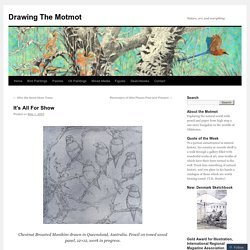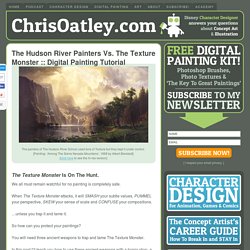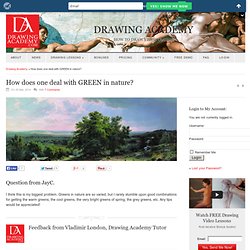

Drawing The Motmot. It’s All For Show Chestnut Breasted Manikins drawn in Queensland, Australia.

Pencil on toned wood panel, 12×12, work in progress. With a solo show coming up in August at JRB Gallery, I’ve got my nose to the grindstone (ow) while burning the midnight oil. The theme is a tropical one, an Explorer/Naturalist/Artist Goes To Exotic, Tangled Jungle Locales and Comes Back Alive With Sketchbooks Filled.
Drawing forums. Russell Stutler's Book about Sketching, Page 13: How to sketch (continued) Page 13.

How to Sketch (continued) Basics of drawing The traditional method of drawing you find in a lot of books is to map out all the angles and relationships and perspective lines and basic shapes very systematically. Lots of cones and cubes and spheres in a matrix of perspective lines radiating from a vanishing point.
This method can be very frustrating if you get the basic relationships wrong in the beginning, or miscalculate the location of vanishing points. Rambling continuous line contour drawing Take your pencil and start drawing exactly what you see in front of you as if your eye were a camera, tracing lines as you see them, and always staying aware of spatial relationships and angles. Try not to lift your pencil because it gives you one more way to measure and verify distances as you feel it travel over the paper.
You can draw as slowly as you need. This type of contour drawing almost forces you to draw exactly what is in front of you. Squinting Beauty of line Hatching. Thanks for subscribing! - Sketchbook Skool Blog. The Hudson River Painters Vs. The Texture Monster. Email The painters of The Hudson River School used tons of Texture but they kept it under control.

[Painting: ‘Among The Sierra Nevada Mountains’, 1868 by Albert Bierstadt] [click here to see the hi-res version] The Texture Monster Is On The Hunt. We all must remain watchful for no painting is completely safe. When The Texture Monster attacks, it will SMASH your subtle values, PUMMEL your perspective, SKEW your sense of scale and CONFUSE your compositions. …unless you trap it and tame it. So how can you protect your paintings? You will need three ancient weapons to trap and tame The Texture Monster. In this post I’ll teach you how to use these ancient weapons with a horror story, a history lesson, a video tutorial and a Downloadable PDF that you can share, print, load onto your mobile device etc… So read on.
…if you dare. The Attack Of The Texture Monster: Here’s how the horror story goes… The promise of those studies supports an elegant line drawing and your confidence builds. But nothing works. Urban sketchbook. Line Drawing: A Guide for Art Students. Figure & Gesture Drawing Practice ToolFigure. Posemaniacs.com. Character Designs - An Artist's Resource. Fine Art Video Lessons « Web Art Academy Course. Drawing Lessons - Video Tutorials presented by Drawing Academy. Bones. Gallery 2014. Pearltrees Extension. How does one deal with GREEN in nature? - Drawing Academy. Question from JayC.

I think this is my biggest problem. Greens in nature are so varied, but I rarely stumble upon good combinations for getting the warm greens, the cool greens, the very bright greens of spring, the grey greens, etc. Any tips would be appreciated! Feedback from Vladimir London, Drawing Academy Tutor Ivan Ivanovich Shishkin – Album Landscape paintings by Ivan Ivanovich Shishkin. Right-click and choose “Save Link As” to save this Album. Download Album » Dear Jay C Many thanks for your question. I have to say that the most natural way is to “stumble upon” a good mixture. If you are serious about painting, then learning the colors of materials is essential. Great art comes from a talent that is based on the artist’s skills, knowledge, experience, and creativity; it does not depend on paint manufacturers. There are two opposite points of view among fine artists concerning greens. Let’s start with the Old Masters.
Sometimes Shishkin would add black paints into green mixes.